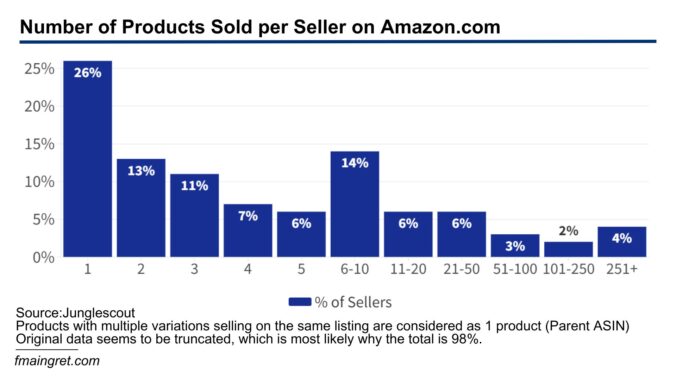Generative AI has been all the rage for a while now. How many marketers use Chat-GPT to generate engaging copy for their product pages? Here’s some major news for those who do: Amazon is launching generative AI features to help sellers create product listing content.
“Yay, even less work!” some might say. And yes, it will make life easier for some sellers. But I can see some potential negative consequences for third-party sellers. These new features could also be a very smart move from Amazon to gain market share on the global ecommerce sales, and help them compete with Temu and Shein.
Let’s first see what this is and who could benefit from it. Then, I’d like to tell you about the potential dark side of Amazon’s generative AI. While this is just speculation and theories, I think this should be carefully considered by ecommerce entrepreneurs, including those who don’t sell on the marketplace.
Amazon’s New Feature Can be Game-Changing for Some Sellers
The first thing that came to my mind when I heard about it is how much time sellers can save. According to JungleScout data, 77% of sellers have 10 or fewer products listed on Amazon. For them, generative AI could be a way to optimize their listings and generate new ideas. It’s unclear if the content generated by Amazon’s AI will be optimized for product searches. If that is the case, this tool will be extremely valuable.
However, for the 4% of sellers having over 250 products to sell, not including variation, this can potentially make their life easier and save them a lot of time. For example, those selling craft hobby items could benefit from it. These sellers typically have a lot of SKUs with many variations. Generative AI can help them save a lot of time on listing creation. For others, it will depend on how good the AI is. If a company sells car parts, they may have to deal with numerous product listings. But in that case, technical specification and compatibility mean a lot more to consumers than sales copy. Can the AI get it right most of the time? Another example is companies selling collectibles. Yes, some help in creating listings can help, but what matters the most for these products is the item condition, shown on product pictures. AI still can’t take these pictures for sellers, so the productivity gains won’t be as important in that case.
Now I’d love to hear feedback from sellers on the quality of the generated content, and how relevant it is to the product sold. According to Amazon, in their recent announcement: “We always encourage sellers to review our generated product details before they submit them to our store, and already, the majority of AI-generated listings are being submitted, with sellers accepting suggested attributes nearly 80% of the time with minimal edits.” Does that mean that AI produces great results, better than what some sellers could do? Or would sellers prefer mediocre AI-generated content over barely having any content at all?

Some Potential Negative Consequences of Amazon’s Generative AI for Sellers
While this new feature can benefit many US-based sellers, I see many potential negative consequences. I have no proof that this will be a reality; the following ideas are purely speculation. I still think sellers can have valid concerns regarding Amazon’s generative AI, like on any other update or new feature.
As I explained in my previous article on Inventory Placement fees, there is a theory gaining traction among US-based third-party sellers and some industry experts that Amazon tends to favor Chinese sellers operating from China. I don’t know about this theory, but I can see how generative AI can help make Chinese sellers more competitive. While some listings created by Chinese sellers are great, and the general quality of Chinese sellers’ content is improving, many listings are still low quality, using poor English. Generative AI can help these sellers close the quality content gap with US-based listings.
Then, there is the question of how Amazon generative AI comes up with high-quality content. I am not an AI expert, please correct me if I’m wrong. I believe that to improve product copy, Amazon could analyze similar products’ listings performance and content, and use its best parts to generate content. Copying part of a successful listing would be ethically questionable, especially for sellers who put in a lot of effort into their copy. But again, there is no evidence this would be the case, and I am hoping this will not happen.
Finally, this new feature will allow sellers to generate content for their Amazon listings based on their own website URL. That sounds like great news for those selling on both channels, and a good way to save time when building the Amazon listing. However, this can potentially act as a way for Amazon to monitor the price of products sold outside of the marketplace (Amazon tends to take the buybox away from merchants selling their products for cheaper on other channels, which the FTC is investigating currently – see more here https://www.linkedin.com/pulse/amazon-hot-waters-deep-dive-recent-antitrust-lawsuit-maingret/?trackingId=hQWTDIReQLWP6uGxH%2FsY2Q%3D%3D ) . I see this feature as a strategy for Amazon to incentivize sellers who don’t have all of their products listed on Amazon to sell them on the marketplace. This would drive traffic away from sellers’ D2C websites to Amazon.
Conclusion
In conclusion, while the introduction of Amazon’s generative AI presents exciting opportunities for sellers, it also raises valid concerns. These include ethical considerations regarding content generation, and implications for pricing and marketplace dominance. It’s essential to approach these discussions with a balanced perspective, recognizing the speculative nature of these concerns. Communication is key and I hope that there will be enough transparency on how these new features work.

